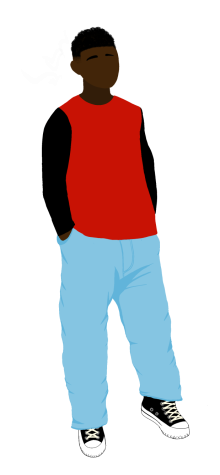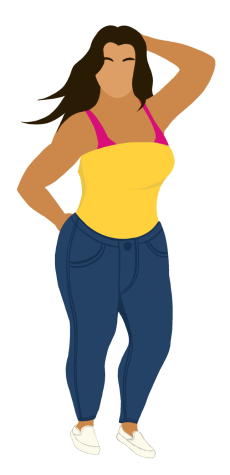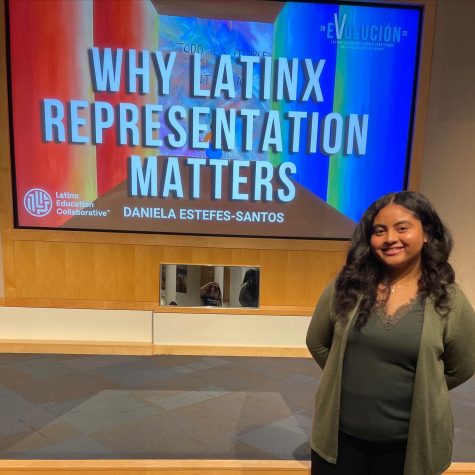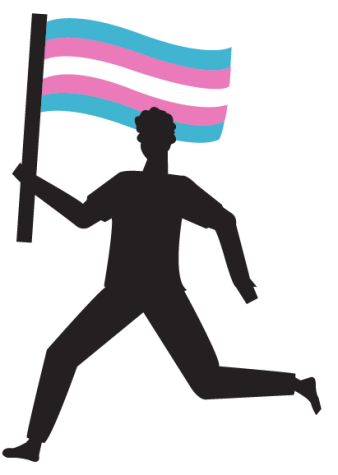Dress-Coded

You walk into your first hour wearing the new outfit you bought at the mall over the weekend, only for your teacher to yell at you to cover up. With the claim of the dress code prohibiting it, you have to wear a sweatshirt over your top for the rest of the day. Dress codes are widely implemented, but are they worth it at the expense of publicly shaming students and interrupting class time?
Dress codes have long been a point of contention in many districts across the country. Controversies have included gender-based hair and clothing requirements, religious and racial discrimination through the dress code, and more recently, whether schools should be allowed to require masks through the dress code. Olathe North has a less extreme dress code policy than other schools, but many North students believe it still isn’t fair.
According to the 2021-2022 Olathe North Student Handbook, “dress or appearance that is likely to cause disruption of the educational process or create a health or safety concern will be considered inappropriate.” Clothing items may be deemed inappropriate if they don’t cover enough skin, show undergarments, or display content such as language or drugs.
“The negative is telling people, mostly girls, [that they] should cover up so that students can concentrate, but what they are really doing is sexualizing teenagers,” sophomore Hope Braaten said.
Many students, including senior Callie Brewer, have been dress-coded for minor infractions that they didn’t believe were disrupting class.
“I used to get called out in class for my shirt riding up past my belly button, which wasn’t really something I could help and it sure wasn’t distracting anyone,” Brewer said.

In addition to ensuring that a student’s outfit is appropriate, dress codes are often used to prepare students for dressing professionally in the workforce.
“This doesn’t make sense, seeing as we can wear sweatpants and ‘bummy’ clothes all we want, but as soon as a skirt is too short it is unprofessional,” Brewer said. “It feels more like an excuse to objectify students than a dress code. If the goal is to dress like adults, the dress code would and should include no open toed shoes, no tank tops, no hats, etc. otherwise there is no inherent need for a dress code.”
A common reason that students are told to cover up is that their outfit is inappropriate and distracting to those around them. However, Braaten disagrees with these grounds.
“The rule that students can’t show their shoulders is not needed whatsoever,” Braaten said. “Our shoulders shouldn’t be sexualized, because no guy I know cares whether my shoulders are covered up or not.”
Although the dress code rules are applied equally to all students, junior Alex Teasley believes that it still contains some bias.
“I think that historically, dress codes have been used to go after marginalized groups like people of color, certain sexualities or gender presentations,” Teasley said.
For example, the dress code specifically bans crop tops, which are traditionally a women’s style.
“Our dress code […] includes language that is exclusive for women’s styles, in a way that is just trying to penalize women,” Teasley said.
The dress code also bans shorts that are too short and tops without straps, which are also clothing items predominantly worn by feminine-presenting people.
“Men aren’t discriminated against or harassed the same way that the dress code harasses women,” junior Chinagorom Ibeagu said. “Especially in a school area, it doesn’t put your education first, it puts the way that you present yourself first.”

Ibeagu also believes that the dress code targets students with different body sizes.
“I think that the dress code is kind of subjective, things can be seen as more promiscuous or showing off more, on a bigger-bodied person,” Ibeagu said. “And I think that’s where I truly disagree with it, I don’t understand how some people are allowed to wear certain things that other people cannot just for having different body sizes, and that’s something that I really hate.”
Although the dress code doesn’t have specific language that discriminates against different body sizes, plus-sized women are often dress-coded more than their thinner classmates.
“I could wear a tank top, but as a bigger-bodied person, I would not get the same reaction as if a smaller person wore the exact same tank top,” Ibeagu said.
To limit the discrimination that dress codes are prone to, Teasley supports using simpler language that doesn’t use terms specific to a certain gender.
“I think that a dress code should just enforce dressing appropriately, and shouldn’t hinder presentation at all,” Teasley said. “It should basically just be like, ‘please wear a shirt, shoes, and pants.’ That’s kind of my ideal dress code.”
Students including Braaten and Brewer have found that different teachers enforce the dress code differently.
“It’s mostly the older women teachers who dress code anyone. I think it’s the difference in our generations,” Braaten said.
In order to refer a student for a dress code violation, teachers have to decide if a student’s outfit is appropriate, and this makes Ibeagu uncomfortable.
“It is more awkward as like a girl to be dress coded by a male teacher, because it’s like, ‘why were you looking at me that way?’” Ibeagu said.
Dress codes and the sexualization of teenagers’ bodies have also been found to be detrimental to students’ mental health, and have been linked to conditions like depression and eating disorders. Brewer is against teachers holding this kind of power over students.
“At North, it’s not enforced nearly as much as it was a few years ago, which is wonderful, but it still feels like a weapon utilized by teachers to make us feel embarrassed and insecure,” Brewer said.
Brewer is glad about the change in attitudes about the dress code at Olathe North, citing teachers as they catalyst for this change.
“I’ve noticed all of my teachers this year who are kind, understanding, and open with their students have said the dress code is sexist and irrelevant in their class,” Brewer said. “They understand how awful it makes the female students feel to be berated, and how sexualized it feels when an adult deems your clothes and body ‘inappropriate for others.’”
With all the negative effects of having a dress code, would not having one be more beneficial for students? Ibeagu thinks so.
“I think taking away [the] dress code wouldn’t do anything but better everyone,” Ibeagu said. “I think it would finally put everyone on an even playing ground.”

Eve is a senior, and this is her fourth year on staff and second as editor-in-chief. Her favorite topics to write on are social issues, legislation, and...

Mallory is a senior and this is her second year on the paper. Her favorite part of newspaper is being able to write about a lot of different topics, especially...







